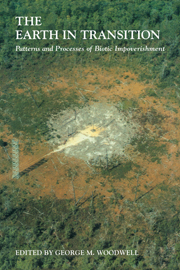Book contents
- Frontmatter
- Contents
- Preface
- Acknowledgments
- List of Contributors
- Part I Global Change and the Patterns of Impoverishment
- Part II Chronic Disturbance and Natural Ecosystems: Forests
- 8 The Restoration of Nonsuch Island as a Living Museum of Bermuda's Precolonial Terrestrial Biome
- 9 Patterns of Impoverishment in Natural Communities: Case History Studies in Forest Ecosystems – New Zealand
- 10 Changes in the Eucalypt Forests of Australia as a Result of Human Disturbance
- 11 Impoverishment in Pacific Island Forests
- 12 Deforestation in Brazilian Amazonia
- 13 Incentives for Sustainable Forest Management
- Part III Chronic Disturbance and Natural Ecosystems: Woodlands, Grasslands, and Tundra
- Part IV Chronic Disturbance and Natural Ecosystems: Aquatic and Emergent Ecosystems
- Part V Conclusion: Steps toward a World That Runs Itself
- Name Index
- Subject Index
13 - Incentives for Sustainable Forest Management
Published online by Cambridge University Press: 24 November 2009
- Frontmatter
- Contents
- Preface
- Acknowledgments
- List of Contributors
- Part I Global Change and the Patterns of Impoverishment
- Part II Chronic Disturbance and Natural Ecosystems: Forests
- 8 The Restoration of Nonsuch Island as a Living Museum of Bermuda's Precolonial Terrestrial Biome
- 9 Patterns of Impoverishment in Natural Communities: Case History Studies in Forest Ecosystems – New Zealand
- 10 Changes in the Eucalypt Forests of Australia as a Result of Human Disturbance
- 11 Impoverishment in Pacific Island Forests
- 12 Deforestation in Brazilian Amazonia
- 13 Incentives for Sustainable Forest Management
- Part III Chronic Disturbance and Natural Ecosystems: Woodlands, Grasslands, and Tundra
- Part IV Chronic Disturbance and Natural Ecosystems: Aquatic and Emergent Ecosystems
- Part V Conclusion: Steps toward a World That Runs Itself
- Name Index
- Subject Index
Summary
Editor's Note: Economic gradients usually dominate in determining details of the management of resources, including land and forests. One of the most important examples is the influence that inexpensive oil and cheap transportation have had on the use and value of land and the size and shape of cities in the United States and eleswhere. Cheap energy has enabled the spread of dwellings across the landscape; has raised the value of rural land for housing beyond its value for farm, pasture, or forest; and has favored massive agricultural enterprises far from markets. The management of forests, too, has yielded again and again to economic gradients that place a hundred years’ experience with research in forestry secondary to the expense of harvesting. Monster clipping machines now wander across the landscape, mowing forests in acre increments, building clearcuts on clearcuts no matter what science and common sense might dictate.
Robert Repetto, an economist on the staff of the World Resources Institute, examines in lucid detail the economic forces that are currently leading to deforestation around the world. Most such gradients are artificial, sometimes flagrantly corrupt, often established or condoned by governments for the advantage of some favored few at public expense. One of the most flagrant examples is the practice of the U.S Forest Service of supporting “logging on over a hundred million acres of national forests that are economically unfit for sustained timber production. production... The timber is sold at prices that do not cover governmental expenses, with a cost to the taxpayers of a hundred million dollars a year."
- Type
- Chapter
- Information
- The Earth in TransitionPatterns and Processes of Biotic Impoverishment, pp. 239 - 256Publisher: Cambridge University PressPrint publication year: 1991



